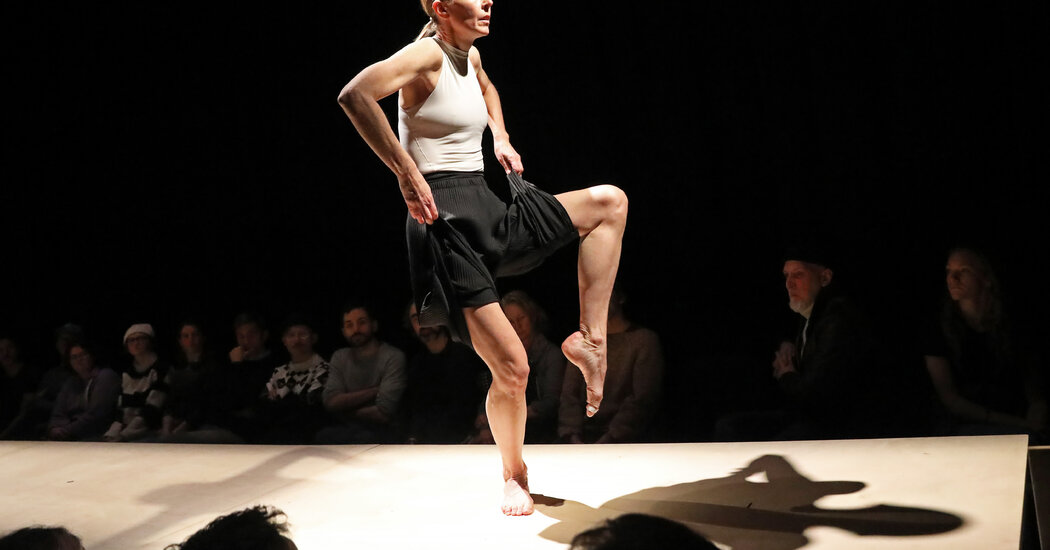For Irish dancers, “Riverdance” was cataclysmic. That 1995 production took a form of cultural heritage and, by making it sexier and showier, created a world-conquering, indestructible juggernaut that threatened to trample the gentler values of a tradition.
Jean Butler, the female star of that show, has been in recovery ever since. She transformed herself into a contemporary dancer and choreographer, a postmodern minimalist whose work eschews the vulgarity of “Riverdance” through intelligence and reserve.
Recently, she has turned back to her Irish dance past by leading “Our Steps, Our Story,” an imperative and overdue oral history project with the New York Public Library of the Performing Arts. Out of that project emerged a new show, “What We Hold,” which had its North American premiere at the Irish Arts Center on Thursday.
It, too, is postmodern and minimal, intelligent and reserved — and in no way vulgar. Structured something like an installation, it begins with audience members gathering around the champion dancer James Greenan, another “Riverdance” veteran, and watching him practice in front of mirrors. Then they are guided behind a curtain to sit around a long banquet table, upon which Butler and two other women dance. Finally, they are ushered back to the first space to witness a friendly ensemble finale.
Greenan’s practicing introduces us to the grind of training. As he drills the same step over and over for nearly 10 minutes, we can focus on the balance and control behind his perfect symmetry and evenness. Eventually, he stirs in some variations of speed and volume, accentual bursts of sound, with deeper tones and crunch. But this section is like watching someone run on a treadmill, or listening to a virtuoso practice the same few basic scales.
The table section is also elementary, but more deconstructed. The three women repeat a sequence of actions: sliding a pointed toe forward, rolling their shoulders back as their chests lift, stretching their arms by their sides as if grasping weights. These are the postural equivalent of Greenan’s practicing, a foundational stance of identity. In that way, the sequence is a bit like the start of George Balanchine’s “Serenade,” minus the grandeur.
Up on the table, the women become sculptural, on display like catwalk models. In a mirroring duet, Butler and the young, self-possessed Kaitlyn Sardin incorporate a swaying shuffle like the backup dancers in the video for Robert Palmer’s “Addicted to Love.” Butler does a solo in bare feet that has the look of a non-acrobatic balance beam routine, choreographed with some of Trisha Brown’s swing and flow. Butler’s clarity and elegance light up what feels like both a remembering and a fitful search for a different path.
Back in the first space, the eight-member ensemble picks up the repetition of a basic step, clumping together and gradually discovering the communal braiding patterns of Irish dance. Tom Cashin, who is 70 and retired from dancing decades ago, physically mumbles a routine from his youth. Butler and Colin Dunne, who starred in “Riverdance” together, reunite onstage for the first time in more than 20 years for a side-by-side duet that’s sweet and a bit sloppy. (Trying not to be stiff, Dunne goes slack.) At the end, everyone lets loose — a little — and throws up their arms.
Any of those moments could be climactic, but they aren’t. This work seems against that kind of release, or afraid of it. Throughout the show, the sound design (by Ryan C Seaton, who also provides a fragmented and collaged score from his laptop) layers in voices from the “Our Steps, Our Story” oral history. They speak of place and of values, and about how a beautiful dancer doing a simple step is better than an awkward dancer doing everything but the kitchen sink.
This is conservatism, a reaction against the acceleration and complexifying of competitions and the post-“Riverdance” profession. It’s a kind of Irish classicism, noble and valuable, and Butler has fused it with a minimalist fixation on simplicity and repetition. She has found the commonality. Both are forms of tight control.
For me, only one moment in “What We Hold” had a breath of freedom: the 15-year-old Maren Shanks exploding into floor-skimming, room-circling skipping steps. She held in her body the pride of tradition, but Butler allowed her to briefly take flight. This show effectively communicates what these dancers hold. It could use some more letting go.
Jean Butler
Through March 3 at Irish Arts Center, Manhattan; irishartscenter.org.


